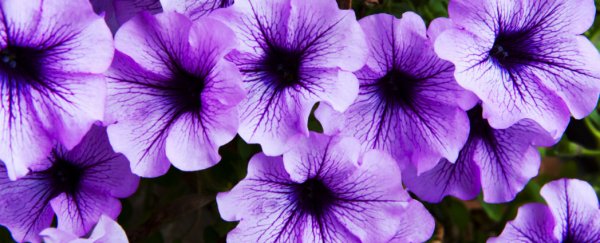Researchers in the US are working on a new variety of petunia that changes colours throughout the day, from red in the morning to blue in the evening, with various purple hues in-between. They're calling it the 'Petunia Circadia,' because its pigment molecules - or anthocyanins - will be expressed based on the plant's circadian rhythm over a 12-hour period.
"No chemicals, no complicated care - just sunlight, soil and a flower that changes colour," Nikolai Braun, co-founder and chief scientific officer of a new biotech company, Revolution Bioengineering, told Diane Nelson at the University of California, Davis (UC Davis). "Plants have circadian rhythms, or cyclical expression of genes throughout the day. These rhythms allow them to start photosynthesis when the Sun comes up, for example, or release fragrance in the evening when their pollinators are active. Petunia Circadia will harness this internal clock to regulate flower colour."
Braun and his colleague, Keira Havens, haven't mastered the Petunia Circadia just yet, but as you can see above, they're well on their way. So far, they've managed to engineer a petunia that grows white, and turns pink over a 24 hour period, when an ethanol solution is applied. It works because when the flower is about to bloom, it's unable to produce pigment-containing anthocyanins, so appears white. But when ethanol is applied, this repairs the pathways that are needed to distribute the pigment throughout the flower's cells.
"The petunia typically produces white blooms, but if you water it with the ethanol solution, the existing flowers will go from white to red and new flowers will bloom a purplish red," Braun told Megan Gambino at Smithsonian Magazine. "The flowers are typically all white because the enzymatic pathway to produce anthocyanins is broken at an early step. When elements in the cell come in contact with ethanol, they will cause the missing enzyme in the anthocyanin pathway to be produced, and the flower will turn that purple colour."
All it takes is a little fresh water to shift the flower back into a pristine white.
While these cute new flowers aren't meant to be anything other than a sweet little curiosity, Braun and Havens hope they will help introduce people to the benefits offered by genetically modified plants. "For almost everyone outside of the farming world, it will be the first time they will have interacted with a genetically modified organism, and by engineering traits for consumers - flower colours, shapes, smells." Braun told Gambino at Smithsonian Magazine. "We hope to normalise that technology to eventually fully realise the promise of plant biotech to provide food, fuels, and fibres in a sustainable way."
Gambino reports that the pair is looking into how to create single plants that produce many different coloured flowers, and flowers that produce new scents, and new patterns, such as polka dots.
Plant geneticist Pam Ronald at UC Davis told press officer Diane Nelson that projects like this could help educate people about her own research. Recently, she managed to develop genetically engineered bananas that are resistant to the Xanthomonas wilt disease, which has already destroyed millions of acres of fruit trees in East Africa, where they're a staple food source.
"It can be hard to connect to the reality of people struggling in far-away places," she told UC Davis. "So when you tell people that genetic engineering can be used to fight hunger by increasing vitamin content and reducing crop loss to insects, sometimes it just doesn't register. Maybe seeing this technology at work in your own backyard can make the science more accessible."
Source: Smithsonian Magazine
